Originally posted by Confirming Truth:
henna'ed hair:


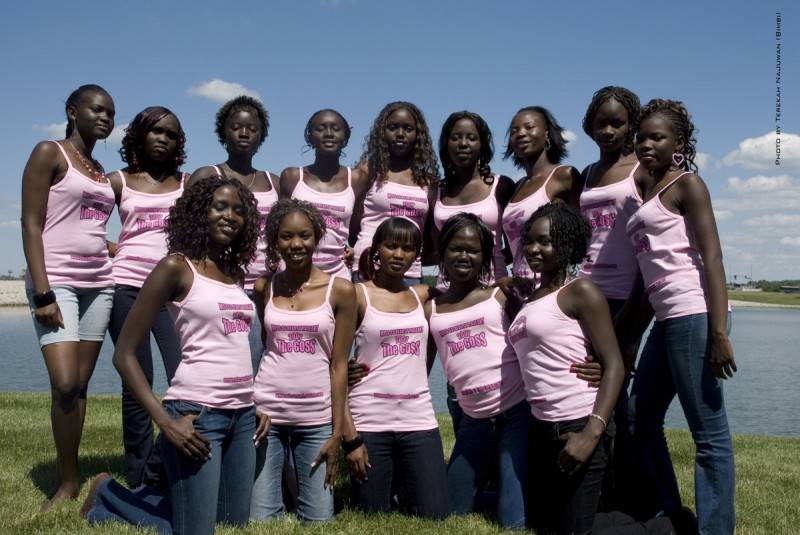

quote:Well idiot, you need to adres your point better. Because now you're not cutting it. But look plain stupid.
Originally posted by Confirming Truth:
^My point is the idiot is using the wrong artwork to prove that Nubians looked like ancient Egyptians.

quote:Retard, pile of sh*t, you claimed that the red/ ruddy colored individuals weren't naturally this complexion. Are you senile or what, it's on 20 minutes ago.
Originally posted by Confirming Truth:
^ I never said that you would not find different tones to the black complexion, idiot. Go back and re-read the post, clown. Nubians DID NOT look like the ruddy complected ancient Egyptians. The ancient Egyptian artists went to painstaking length to note this fact in their artwork.
![[Big Grin]](biggrin.gif)
![[Mad]](mad.gif)
![[Eek!]](eek.gif)
quote:No, it's not.
Originally posted by Confirming Truth:
^My point is the idiot is using the wrong artwork to prove that Nubians looked like ancient Egyptians.
quote:We are dealing with another wierdo here, who can't make up it's mind. Or is more likely high on some meth. Trying to shift the subject from hair to skin from skin to hair to ethnic background etc.....smh....hilarious....your life must be boring...Pathetic individual.
Originally posted by Confirming Truth:
henna'ed hair:

quote:
Originally posted by Ish Gebor AKA Troll Patrol:
quote:Retard, pile of sh*t, you claimed that the red/ ruddy colored individuals weren't naturally this complexion. Are you senile or what, it's on 20 minutes ago.
Originally posted by Confirming Truth:
^ I never said that you would not find different tones to the black complexion, idiot. Go back and re-read the post, clown. Nubians DID NOT look like the ruddy complected ancient Egyptians. The ancient Egyptian artists went to painstaking length to note this fact in their artwork.
Incredible......![[Big Grin]](biggrin.gif)
![[Mad]](mad.gif)
![[Eek!]](eek.gif)
quote:
Originally posted by Ish Gebor AKA Troll Patrol:
quote:We are dealing with another wierdo here, who can't make up it's mind. Or is more likely high on some meth. Trying to shift the subject from hair to skin from skin to hair to ethnic background etc.....smh....hilarious....your life must be boring...
Originally posted by Confirming Truth:
henna'ed hair:

quote:Blah blah...they aren't even Nubian...they are Nuba to begin with. Dumb asswhite. And Nubains come in lighter complexions. And Nuba come in the complexrion as is depicted. That myth has been dispelled, so you ran to..but the hair.....but the this the that.....
Originally posted by Confirming Truth:
no asswhipe, re-read what i said. Black Nubians did come in different tones, but not ruddy like the Egyptians, in significant numbers. The artwork that the clown used is not proof that the Nubians ranged in complexion similar to the Egyptians, turd.
quote:
Originally posted by Ish Gebor AKA Troll Patrol:
quote:Retard, pile of sh*t, you claimed that the red/ ruddy colored individuals weren't naturally this complexion. Are you senile or what, it's on 20 minutes ago.
Originally posted by Confirming Truth:
^ I never said that you would not find different tones to the black complexion, idiot. Go back and re-read the post, clown. Nubians DID NOT look like the ruddy complected ancient Egyptians. The ancient Egyptian artists went to painstaking length to note this fact in their artwork.
Incredible......![[Big Grin]](biggrin.gif)
![[Mad]](mad.gif)
![[Eek!]](eek.gif)
![[Big Grin]](biggrin.gif) .
.
quote:Pale devil, you claimed that the skin was not natural. It was debunked quickly quite frankly.
Originally posted by Confirming Truth:
DODObrain, the point is the scene in that particular artwork is showing a henna'ed nigger convoy, that is all.
quote:
Originally posted by Ish Gebor AKA Troll Patrol:
quote:We are dealing with another wierdo here, who can't make up it's mind. Or is more likely high on some meth. Trying to shift the subject from hair to skin from skin to hair to ethnic background etc.....smh....hilarious....your life must be boring...
Originally posted by Confirming Truth:
henna'ed hair:

![[Big Grin]](biggrin.gif)
![[Big Grin]](biggrin.gif)
![[Razz]](tongue.gif)
quote:Where does it say the have henna on? And I already posted pics of Nuba with lighter complexion.
Originally posted by Confirming Truth:
Henna'ed nigger's delight.
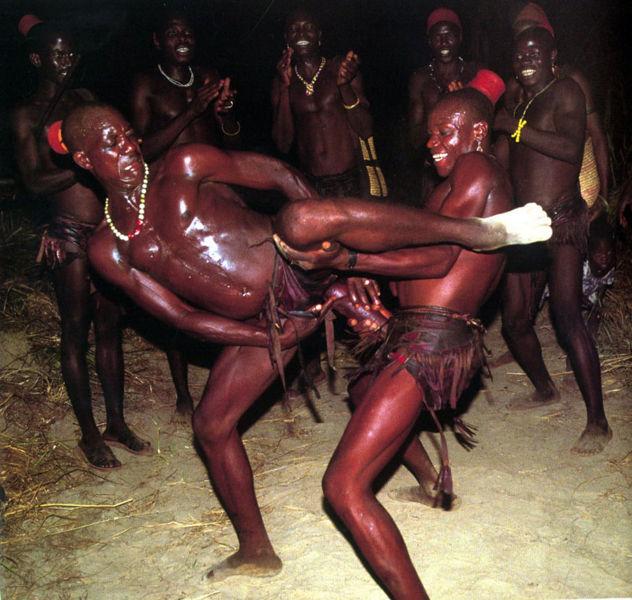
![[Wink]](wink.gif)

quote:Really, where is it?
Originally posted by Confirming Truth:
^In another post I had to take you by the hand and explain to you in simple baby terms what was posted.
![[Wink]](wink.gif)
![[Big Grin]](biggrin.gif)
![[Wink]](wink.gif)
![[Razz]](tongue.gif)
quote:
Originally posted by Ish Gebor AKA Troll Patrol:
Pale devil, you claimed that the skin was not natural. It was debunked quickly quite frankly.![[Big Grin]](biggrin.gif)
![[Big Grin]](biggrin.gif)
![[Razz]](tongue.gif)
Now you nigger this and that. Because you can't make any sense. [/qb]
quote:Go back here http://www.egyptsearch.com/forums/ultimatebb.cgi?ubb=get_topic;f=15;t=005157 and answer the question that I asked you. Why did you run away? I'll ask you the same question here:
Originally posted by Confirming Truth:
The idiot is using the following pix to "prove" his claim. Notice the henna on the lion's mane and hair of the black Nubians. This suggests that the red Nubians are red because of Henna use, not because of skin complexion. Once again, Afrocentric Epic Fail.

quote:Cave dweller, tell me is the man in the front who happens to be a real Nuba, unlike your fake claims, natural this color or is it henna.
Originally posted by Confirming Truth:
Niggerdumb, it is really quite obvious that the artist stylized the work to contrast red and black with the intent to emphasize the cultural practice of henna dying. The art does not prove that Nubians ranged in skin tone comparable to ancient Egyptians. The artist simply captures henna use on Niggers and stylizes it in the painting. Okay, niggerdumb?
quote:
Originally posted by Ish Gebor AKA Troll Patrol:
quote:Pale devil, you claimed that the skin was not natural. It was debunked quickly quite frankly.
Originally posted by Confirming Truth:
DODObrain, the point is the scene in that particular artwork is showing a henna'ed nigger convoy, that is all.
quote:
Originally posted by Ish Gebor AKA Troll Patrol:
quote:We are dealing with another wierdo here, who can't make up it's mind. Or is more likely high on some meth. Trying to shift the subject from hair to skin from skin to hair to ethnic background etc.....smh....hilarious....your life must be boring...
Originally posted by Confirming Truth:
henna'ed hair:

![[Big Grin]](biggrin.gif)
![[Big Grin]](biggrin.gif)
![[Razz]](tongue.gif)
Now you nigger this and that. Because you can't make any sense.
![[Big Grin]](biggrin.gif)
![[Wink]](wink.gif)
![[Razz]](tongue.gif)

quote:The ilk can't, because the ilk is living in a world of white illusions and fantasies.
Originally posted by awlaadberry:
quote:Go back here http://www.egyptsearch.com/forums/ultimatebb.cgi?ubb=get_topic;f=15;t=005157 and answer the question that I asked you. Why did you run away? I'll ask you the same question here:
Originally posted by Confirming Truth:
The idiot is using the following pix to "prove" his claim. Notice the henna on the lion's mane and hair of the black Nubians. This suggests that the red Nubians are red because of Henna use, not because of skin complexion. Once again, Afrocentric Epic Fail.

Show me a Nubian with henna on his body from head to toe. And show me where it's the custom of Nubians to but henna on their bodies from head to toe.
quote:I never claimed he's Egyptian. I stated he is Nuba. Just like the people in the image. It's you who claims they are Nubians. The Major epic failure is by you, since you claimed the "Nuba" (hum....Nubians ...lol) only can be of a certain dark complexion.
Originally posted by Confirming Truth:
^Clown, the guy in the front does not resemble an ancient Egyptian. Your point is an epic fail. Try again, porch-monkey.




quote:I don't know to who you are writing exactly here, but I assume is me.
Originally posted by Confirming Truth:
^No asshole. An asshole, just like yourself, tried to use the painting to claim that Nubians and Ancient Egyptians were one and the same because both were ruddy complected, hence, the painting in question. This is total bullshit, but expected from asshole Afro-nutters. Nubians were BLACK. Egyptians were ruddy. Nubians ranged in different shades of Black. They did not range in the ruddy complexion like the Egyptians. Because you tried to come to the rescue of your fellow countryman, therefore, you must be defending his position (the artwork can be used to prove ancient Egyptians were Negroes). You are worst than someone mentally slow. You are Niggertard.
quote:Who are you talking to here?
Originally posted by Confirming Truth:
^No asshole. An asshole, just like yourself, tried to use the painting to claim that Nubians and Ancient Egyptians were one and the same because both were ruddy complected, hence, the painting in question. This is total bullshit, but expected from asshole Afro-nutters. Nubians were BLACK. Egyptians were ruddy. Nubians ranged in different shades of Black. They did not range in the ruddy complexion like the Egyptians. Because you tried to come to the rescue of your fellow countryman, therefore, you must be defending his position (the artwork can be used to prove ancient Egyptians were Negroes). You are worst than someone mentally slow. You are Niggertard.
quote:I believe she is quite a few shades lighter than those man (Which you sneaky took away.) I posted within the same posting. Just like in that piece of ancient art you posted.
Originally posted by Confirming Truth:
This is not a ruddy complected person, asswhipe.


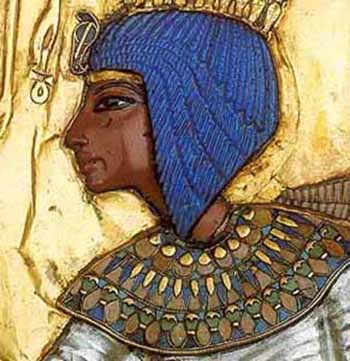
 ....yet ah him sleep with di monkey and bring AIDS inna mankind...rather ironic I'd say...smh....
....yet ah him sleep with di monkey and bring AIDS inna mankind...rather ironic I'd say...smh....
quote:
Originally posted by Ish Gebor AKA Troll Patrol:I don't know to who you are writing exactly here, but I assume is me.
Hummm retarded white ass, I posted no picture. It was you who did. I only responded to you inconsistent crap. Second you lack critical understanding of African tribes/ ethnic groups.
From inside Egypt and outside Egypt. Which is quite amusing. [/QB]
quote:Who is "he"?
Originally posted by Confirming Truth:
I did not say you posted anything, but you did come to his rescue by contesting my points. So, you obviously agree with how he interprets the artwork. There is no inconsistency on my part, numbnut. The problem is you are an interloper who failed to abreast himself of the points made from the beginning that the idiot and I exchanged arguments.
Now.... fvck yourself royally.
quote:[/QB]
Originally posted by Ish Gebor AKA Troll Patrol:I don't know to who you are writing exactly here, but I assume is me.
Hummm retarded white ass, I posted no picture. It was you who did. I only responded to you inconsistent crap. Second you lack critical understanding of African tribes/ ethnic groups.
From inside Egypt and outside Egypt. Which is quite amusing.
quote:
Originally posted by Ish Gebor AKA Troll Patrol:I believe she is quite a few shades lighter than those man (Which you sneaky took away.) I posted within the same posting. Just like in that piece of ancient art you posted.
quote:Well, in your initial post you made a claim, which was false. But your pride is too great to admit you were wrong.
Originally posted by Confirming Truth:
I did not say you posted anything, but you did come to his rescue by contesting my points. So, you obviously agree with how he interprets the artwork. There is no inconsistency on my part, numbnut. The problem is you are an interloper who failed to abreast himself of the points made from the beginning that the idiot and I exchanged arguments.
Now.... fvck yourself royally.
quote:[/QB]
Originally posted by Ish Gebor AKA Troll Patrol:I don't know to who you are writing exactly here, but I assume is me.
Hummm retarded white ass, I posted no picture. It was you who did. I only responded to you inconsistent crap. Second you lack critical understanding of African tribes/ ethnic groups.
From inside Egypt and outside Egypt. Which is quite amusing.
![[Big Grin]](biggrin.gif)
![[Embarrassed]](redface.gif)
quote:
Originally posted by awlaadberry:
Who is "he"?
quote:
Originally posted by Ish Gebor AKA Troll Patrol:
quote:Well, in your initial post you made a claim, which was false. But your pride is too great to admit you were wrong.
Originally posted by Confirming Truth:
I did not say you posted anything, but you did come to his rescue by contesting my points. So, you obviously agree with how he interprets the artwork. There is no inconsistency on my part, numbnut. The problem is you are an interloper who failed to abreast himself of the points made from the beginning that the idiot and I exchanged arguments.
Now.... fvck yourself royally.
quote:
Originally posted by Ish Gebor AKA Troll Patrol:I don't know to who you are writing exactly here, but I assume is me.
Hummm retarded white ass, I posted no picture. It was you who did. I only responded to you inconsistent crap. Second you lack critical understanding of African tribes/ ethnic groups.
From inside Egypt and outside Egypt. Which is quite amusing.
So you started denial and mud slinging actions with racial bigotry. So I took up a big rock. And rocked n rolled that nonsense. Mighty hard. [/QB]


![[Wink]](wink.gif)
![[Wink]](wink.gif)
![[Embarrassed]](redface.gif)
![[Confused]](confused.gif)
quote:Well, in your initial post you made a claim, which was false. But your pride is too great to admit you were wrong.
Originally posted by Confirming Truth:
What claim did I make that was false?
quote:
Originally posted by Ish Gebor AKA Troll Patrol:
[QUOTE]Originally posted by Confirming Truth:
[qb] I did not say you posted anything, but you did come to his rescue by contesting my points. So, you obviously agree with how he interprets the artwork. There is no inconsistency on my part, numbnut. The problem is you are an interloper who failed to abreast himself of the points made from the beginning that the idiot and I exchanged arguments.
Now.... fvck yourself royally.
[QUOTE]Originally posted by Ish Gebor AKA Troll Patrol:I don't know to who you are writing exactly here, but I assume is me.
Hummm retarded white ass, I posted no picture. It was you who did. I only responded to you inconsistent crap. Second you lack critical understanding of African tribes/ ethnic groups.
From inside Egypt and outside Egypt. Which is quite amusing.
quote:Exactly!
Originally posted by awlaadberry:
quote:Who is "he"? [/QB]
Originally posted by Confirming Truth:
I did not say you posted anything, but you did come to his rescue by contesting my points. So, you obviously agree with how he interprets the artwork. There is no inconsistency on my part, numbnut. The problem is you are an interloper who failed to abreast himself of the points made from the beginning that the idiot and I exchanged arguments.
Now.... fvck yourself royally.
quote:
Originally posted by Ish Gebor AKA Troll Patrol:I don't know to who you are writing exactly here, but I assume is me.
Hummm retarded white ass, I posted no picture. It was you who did. I only responded to you inconsistent crap. Second you lack critical understanding of African tribes/ ethnic groups.
From inside Egypt and outside Egypt. Which is quite amusing.
quote:Do you know Awlaadberry?
Originally posted by Confirming Truth:
Some dyck by the name: Awlaad-dingleberry.
quote:
Originally posted by awlaadberry:
Who is "he"?
quote:Yes that's henna practice, how ever you have people within the Nuba who are naturally this color.
Originally posted by Confirming Truth:
^Are you fvcking serious?!?!
Thank you, Sero, for the photos. Please refer to Sero's post above yours to see the henna dye practice.
GAME FVCKING OVER. THREAD WIN, AFRONUTTERS LOSE.


quote:Do you actually think that those Egyptian paintings are showing what Sero just posted? You can't be serious!
Originally posted by Confirming Truth:
^Are you fvcking serious?!?!
Thank you, Sero, for the photos. Please refer to Sero's post above yours to see the henna dye practice.
GAME FVCKING OVER. THREAD WIN, AFRONUTTERS LOSE.
quote:
Originally posted by Confirming Truth:
The Nubians in Egyptian art remind me of the Nuba people in Sudan, the largest non Arab group in south Sudan.Interesting is the red body painting and red hair coloring plus the hair feathers.

quote:
Originally posted by Ish Gebor AKA Troll Patrol:
Yes that's henna practice, how ever you have people within the Nuba who are naturally this color.
Why are you ignoring this fact. Even when its in your face.
BTW, again those People are Nuba. Not Nubians...epc...fail...lol
Now, elaborate on my questions will ya'. Regarding your pictures...lol
quote:
Originally posted by Confirming Truth:
The Nubians in Egyptian art remind me of the Nuba people in Sudan, the largest non Arab group in south Sudan.Interesting is the red body painting and red hair coloring plus the hair feathers.

quote:Sero the zero, elaborate. Who are the people you posted. Since they remind you....lol Which tribe, what part of Africa...thanks in advance for your time and effort.lol
Originally posted by sero:
The Nubians in Egyptian art remind me of the Nuba people in Sudan, the largest non Arab group in south Sudan.Interesting is the red body painting and red hair coloring plus the hair feathers.

quote:Ahh, you rely solely on a painting without having further understanding. Ok.lol
Originally posted by Confirming Truth:
Elaborate on fvcking what? I told you, my argument rests on the painting, nothing more, nothing less! Stick to the topic at hand, and enough with the red herrings!
quote:
Originally posted by Ish Gebor AKA Troll Patrol:
Yes that's henna practice, how ever you have people within the Nuba who are naturally this color.
Why are you ignoring this fact. Even when its in your face.
BTW, again those People are Nuba. Not Nubians...epc...fail...lol
Now, elaborate on my questions will ya'. Regarding your pictures...lol
quote:Red herring is when you can't compel and eleborate properly.
Originally posted by Confirming Truth:
Elaborate on fvcking what? I told you, my argument rests on the painting, nothing more, nothing less! Stick to the topic at hand, and enough with the red herrings!
quote:
Originally posted by Ish Gebor AKA Troll Patrol:
Yes that's henna practice, how ever you have people within the Nuba who are naturally this color.
Why are you ignoring this fact. Even when its in your face.
BTW, again those People are Nuba. Not Nubians...epc...fail...lol
Now, elaborate on my questions will ya'. Regarding your pictures...lol
quote:A quick reminder for this cave dweller.
Originally posted by Confirming Truth:
^^Again, asshole, your partner attempted to use a painting to claim that the ruddy Egyptians were the same people - Niggers - from the south. And he based his claim on the 'red skin tone' of the Blacks in the painting. His claim was debunked by myself and sero. Game is over, clown.

quote:Allow my to repeat my original question:
Originally posted by Confirming Truth:
Credit goes to Sero...
The Nubians in Egyptian art remind me of the Nuba people in Sudan, the largest non Arab group in south Sudan.Interesting is the red body painting and red hair coloring plus the hair feathers.




quote:Hilarious, what a dumb ass this is.
Originally posted by Confirming Truth:
^Dumb, ignorant baboon! Who the fvck gets their facts from a blurb?! Wait a sec..., that would be you, LOL!! The title fvcking mocks the idiot who thinks that there are two skin complexions illustrated in the painting, one of which he references to try to prove that the Nubians and Egyptians had the same color. Fact is, the artwork is stylized, contrasting black and red, to draw attention to the henna use of the NIgger tributaries. There is one natural skin color in the artwork and that is black.

quote:The picture showed henna, and other pictures showed Nuba of lighter complexion. Similair to the painting.
Originally posted by Confirming Truth:
Niggers playing in "denial" want to be Egyptian LOL! Besides other things, the painting shows henna practice. If you cannot see that, well, I am not surprised. I am pretty much through with this thread. It has been a success. Another failure for Afroloons.

quote:Confirming Truth. Does the red cow have henna on, too? I'm sorry Confirming Truth, I don't take drugs, so I can't see what you see.
Originally posted by Confirming Truth:
Niggers playing in "denial" (get it? denial, the nile, LOL) want to be Egyptian LOL! Among other things, the painting shows the practice of applying henna to hair and skin. Look at the art technique of contrasting colors to reinforce this...
Red cow and Black cow. Coincidence everything is black and red? LOL!!
If you cannot see that, well, I am not surprised. I am pretty much through with this thread. It has been a success. Another failure for Afroloons.
quote:It's really is in your fantasy world.
Originally posted by Confirming Truth:
Niggers playing in "denial" (get it? denial, the nile, LOL) want to be Egyptian LOL! Among other things, the painting shows the practice of applying henna to hair and skin. Look at the art technique of contrasting colors to reinforce this...
Red cow and Black cow. Coincidence everything is black and red? LOL!!
If you cannot see that, well, I am not surprised. I am pretty much through with this thread. It has been a success. Another failure for Afroloons.
quote:But, you do know there are red and black cows in that region, don't you? lol
Originally posted by Confirming Truth:
^No, it does not have on henna but there is a reason why it was painted red while the other black. Care to explain why?
quote:Yes, homey don't play that .
Originally posted by Confirming Truth:
^Clown, explain why the artist chose only red and black contrasting.



quote:
Originally posted by Confirming Truth:
dumb dumb, I see you cant explain why two specific colors were chosen for the painting. The thread is a win. Go back to the porch, monkey.




quote:Am J Phys Anthropol, 2008.
Originally posted by Confirming Truth:
dumb dumb, I see you cant explain why two specific colors were chosen for the painting. The thread is a win. Go back to the porch, monkey.
quote:Right on, lol
Originally posted by Confirming Truth:
dumb dumb, I see you cant explain why two specific colors were chosen for the painting. The thread is a win. Go back to the porch, monkey.
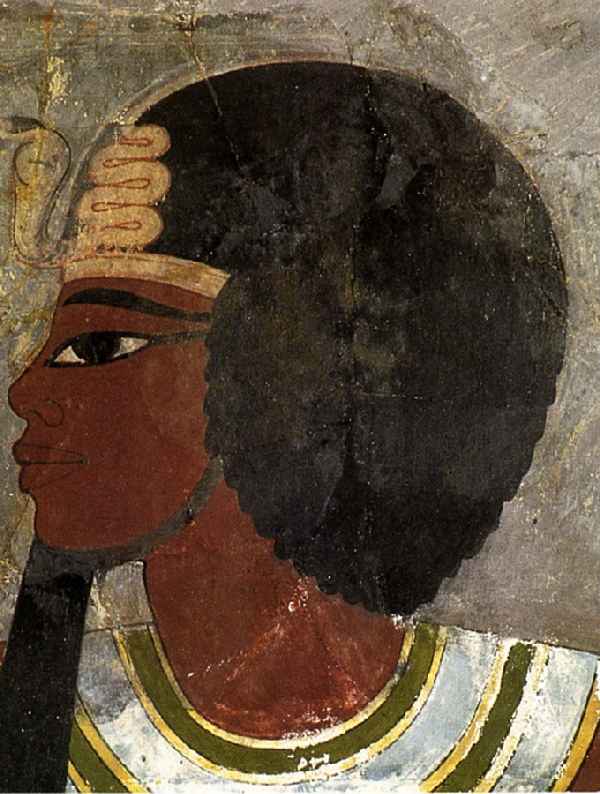
quote:The second question should read:
Originally posted by awlaadberry:
quote:Allow my to repeat my original question:
Originally posted by Confirming Truth:
Credit goes to Sero...
The Nubians in Egyptian art remind me of the Nuba people in Sudan, the largest non Arab group in south Sudan.Interesting is the red body painting and red hair coloring plus the hair feathers.

Who's darker? This person:
or the lighter ones in this picture:
THAT'S MY QUESTION. َAnd the question that I was going to ask next was what group of people were the lighter-skinned ones representing.
Now Confirming Truth, I have some questions for you:
1. Why do you think the person in the first picture is an Egyptian?
2. Why do you think that the people in the second picture are all the same people (the black ones and the reddish ones) and not different peoples?
3. Why do you think the lighter-skinned people are covered in henna and that it's not their actual complexion? Is the man in the first picture covered in henna?
3. You can't possible believe that the ancient Egyptians painted them (the people in the second picture)two different colors to show that they are the same color, but some of them covered themselves in henna from head to toe. Do you actually think that the picture is saying that? Are you really that dumb?
4. Have you never seen people south of Egypt with a complexion like the lighter-skinned ones in the second picture?

DID THEY WANT TO SHOW THIS?
Or did they want to show people walking around with henna on their bodies from head to toe???
quote:The same reason these two men have different complexions - that's the way Allah created them:
Originally posted by Confirming Truth:
^No, it does not have on henna but there is a reason why it was painted red while the other black. Care to explain why?


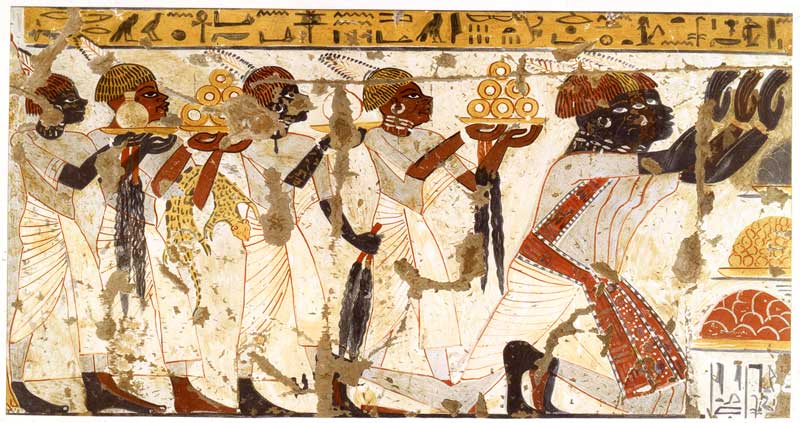

quote:What the heck are you talking about?! Listen to my question again and answer it with a simple yes or no. Does your twisted mind tell you that the lighter-skinned people in the picture below are not lighter-skinned, but covered in henna from head to toe? Yes or no:
Originally posted by Confirming Truth:
^Are you fvcking serious? So you expect me to believe that their hair is naturally red and the way the Egyptians depicted them is irrelevant, huh?
Where is the above guy that the Egyptians modeled after the Negro race? I don't see him in the painting you are now providing. Why? Is it because the occasion in the scene is a religious one, with worshipers using henna in their adoration?
The hair is the give-a-way, clown. The painting is stylized. If you don't believe, look at the girdles around their waist. What color are the ones around the waist of those who lead the procession?




quote:Confirming Truth,
Originally posted by Confirming Truth:
Nubians with henna in hair but not skin:
more accurate depiction of Nubians:

quote:Oh. I see now how much truth you are about confirming. Why am I wasting my time on someone like you?
Originally posted by Confirming Truth:
They are more than likely of the lighter end in the black range skin complexion, to answer your question. They use the henna to enhance their complexion and attain the ruddy Egyptian appearance. You know this is nothing new, Negroes skin bleach to emulate the whites.


 [/QUOTE
[/QUOTE






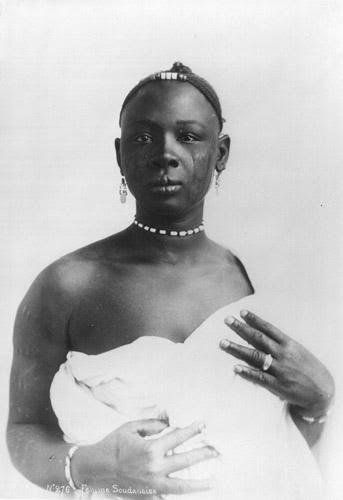
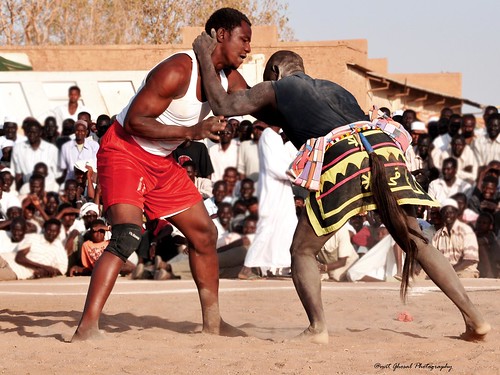

quote:So the red ones are women Lioness? This is madness. No, this is beyond madness! I've never seen such madness in my life. Are these actually adults speaking here?!
Originally posted by the lioness:

__________ hunters incl. boy
_______________________________ mother
_____________________________with daughter
In this region of Sudan in some tribes women cover their bodies in red ochre pigment. This is done in relation to certain reproductive stages.
In the above the red persons are women.
The smaller person with a spear with the hunters is a boy.
A women is in charge of the smaller animals and birds.
men are handling the larger cattle.

Again the females are the red ochre color. The men at the front wear leather belts which hang down and go across the chest.
The younger black colored males (not as large as the front group) don't have this belt and women don't have this belt. In the art the red also is convenient to show that there are both males and females in the scene.
In these paintings you see several people in the same scene together painted black.
In Egyptian art you never see that. You only see people in groups
in various natural skin tone shades of brown. You don't see multiple individuals in the same scene painted jet black as in the above scenes. What you might see in a scen with Egyptians is one jet black individual. They are in scenes representing Osiris (Ausar) or dieties of the afterlife which are associated, not plain humans.
Sometimes you see one of the kings painted jet black, they are representing Osiris. When you see Osiris as Osiris sometimes he's painted black or green.
.
quote:
Originally posted by kenndo:
nubian women
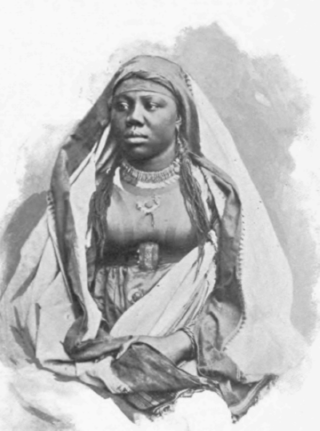

nubianfacialscarring

nubian coffee boy
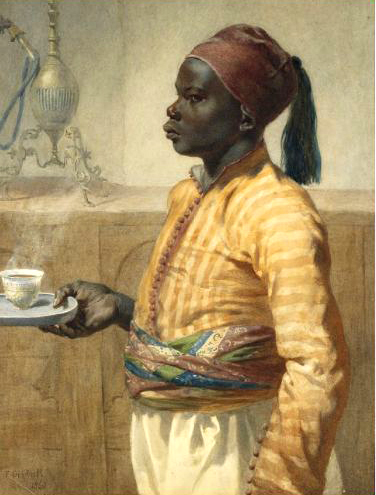
This wrestling known as the “Nubian wrestling” is a residue of the old Nubian culture
It is now practiced by a group of youth in North of Khartoum, the place is named as Souk Sitta
This wrestling is one of humankind's oldest traditions, and the people of the Nuba mountains of Sudan are experts at it. To be a Nubian man is to wrestle. That's what the earliest hieroglyphics show and what the pharaohs of Old Egypt saw.

quote:correction-
Originally posted by kenndo:
[QUOTE]Originally posted by Ish Gebor AKA Troll Patrol:
Are you really this dumb or are you acting this dumb? Smh
These individuals are Nuba btw. Not Nubians.
The main Nuba Tribes are: Moro, Ottoro, Heiban, Leira, Koalib, Shawai, Tira, Miri, Acheron, Fungor, Kau, Nyaro, Lukha, Masakin, Kuku Lumun, Tacho, Turuna, Lafofa, Kadugli, Talodi, Tegali, Tulushi, Keiga, Kanga, Katcha, Dilling,Nymang, Tima, Katla, Korongo, Tumtum,Temin, Um Danab, Lugori, Sabori, Tillo, Shatt, Affiti, Kaderu, Julud, Wali, Karko, Hugeirat, Dalokah, Daju,Ghulfan, Turug,Tingal, Kajaja,Dair,Chioro, Rashad, Tagoi, Tumali,Tumma, and Moreb.
Some of the tribes mentioned above are big and compromise within themselves several smaller subgroups. Keiga, Tira,Ghulfan, Korongo are the best examples for such complexity. Go figure. Retarded dumb white individual. Thinking you have really accomplished something, by your snobistic arrogance.

[/QUOTE
The main Nuba Tribes are: Moro, Ottoro, Heiban, Leira, Koalib, Shawai, Tira, Miri, Acheron, Fungor, Kau, Nyaro, Lukha, Masakin, Kuku Lumun, Tacho, Turuna, Lafofa, Kadugli, TalodiTalodi, Tegali, Tulushi, Keiga, Kanga, Katcha, Dilling,Nymang, Tima, Katla, Korongo, Tumtum,Temin, Um Danab, Lugori, Sabori, Tillo, Shatt, Affiti, Kaderu, Julud, Wali, Karko, Hugeirat, Dalokah, Daju,Ghulfan, Turug,Tingal, Kajaja,Dair,Chioro, Rashad, Tagoi, Tumali,Tumma, and Moreb. Talodi
_________________________________________________
I have not read everything here,i tend do not go on blogs talking about african history anymore,i just stick to the books and get my facts there,but i just came to see what is going on,and maybe i should have not open this this thread,anyway i want to make some corrections.
These are nubians.

_____________________________________
some of of these groups are nubians.
look up the nubian languages and you will see that nubian is spoken in other areas in sudan.
nuba is not a ethnic group,it's a regional group,with different ethnic groups living there.
QUOTE-
Today a large rugged area about 300 miles (500 km) southwest of Khartoum is known as the Nuba Hills. Today the peoples who live there are also called "the Nuba." These Nuba, however, are not one group but many. They speak many different languages and settled here in many waves and at many different times. These modern "Nuba" should not be confused with the "Nubians" (the ancient "Nuba" or "Noba"), for they are very different in language, appearance, and cultural heritage. however centuries ago some "Noba"(NUBIANS) people dwelt here and gave their name to the mountains and that some of the modern "Nuba" ARE descended from them.
subdivision of Nubian languages (in Nubian languages)
...of languages spoken in The Sudan and southern Egypt, chiefly along the banks of the Nile River (where Nobiin and Kenzi [Kenuzi] are spoken) but also in enclaves in the Nuba Hills of central Sudan (Hill Nubian) and in Darfur (where Birked [Birgid] and Midob [Midobi] are spoken). These languages are now considered to be a part of the Nilo-Saharan language family.
or
Nubian languages
group of languages spoken in The Sudan and southern Egypt, chiefly along the banks of the Nile River (where Nobiin and Kenzi [Kenuzi] are spoken) but also in enclaves in the Nuba Hills of central Sudan (Hill Nubian) and in Darfur (where Birked [Birgid] and Midob [Midobi] are spoken). These languages are now considered to be a part of the Nilo-Saharan language family.
The Nuba People-
Nuba Mountains is an area located in South Kordofan, Sudan. The mountains cover an area roughly 40 miles (64 km) wide by 90 miles (140 km) long, and are 1500 to 3,000 feet (910 m) higher in elevation than the surrounding plain. It is arid there, but lush and green compared with most nearby areas. There are almost no roads in the Nuba Mountains; most villages there are only accessible by ancient paths that aren't navigable by motor vehicles. The rainy season extends from mid-May to mid-October, and annual rainfall ranges from 400 to 800 millimeters, allowing grazing and seasonal rain-fed agriculture.
Nuba is a collective term used here for the peoples who inhabit the Nuba Mountains, in the states of Southern Sudan, Africa. Although the term is used to describe them as if they composed a single group, the Nuba are multiple distinct strains and speak different languages. Estimates of the Nuba population vary widely; the the Southern Sudanese government estimated that they numbered 1.07 million in 2003.
THE NUBA NUMBERS IN THE NUBA HILLS ARE ABOUT 1.1 MILLION OR MORE.
NOTE - NUBA ARE NOT THE SAME.MOST ARE NOT NUBIAN BUT SOME ARE.THE HILL NUBIANS LIVE IN THE NORTHERN PART AND OUT OF 1.1 MILLION,ABOUT 370,000 OUT OF 1.1 MILLION NUBIA IN THE NUBA HILLS ARE NUBIAN.there may be more in the nuba hills and outside of it.
The resulting hypothesis regarding the relative chronology of the linguistic settlement of the Nuba Mountains is then:
1. Kordofanian
2. Nyimang; Temein; Kadugli
3. Daju I: Shatt, Liguri
4. Hill Nubian
5. Daju II: Lagawa
Map 1: Language distribution in the Nuba Mountains

Map 2: The distribution of the Nubian and Daju language groups

3. Hill Nubian
Nubian is a language group which presently spreads from Darfur to the Nile (see Map 2). The most prudent interpretation of our lexicostatistical data (Thelwall 1978, 1981a) leads to the subclassification shown in figure 1.
Figure 1: Subclassification of Nubian

# Hill Nubian – a group of closely related dialects spoken in various villages in the northern Nuba Mountains – in particular Dilling, Debri, and Kadaru.
quote-
We may thus assume a large zone from Darfur in the West to the Nile in the East in which Nubian was present during a long period. From this area some Nubians must have come to settle on the northern Nuba Mountains. Whether this occurred due to pressure from Arab nomads as Arkell (1955) proposes, or whether an earlier date should be assumed is not clear. The relative closeness of the Hi1l Nubian dialects to each other does not suggest the presence of isolated Nubian communities in these hills for several millennia.
here are the hill nubians-
the arabized ones and the ones in darfur just mean they do not speak nubian anymore but still nubian in culture .
Garko, Kithonirishe
Ghulfan and arabized Ghulfan
dilling and arabized dilling
Delen, Warki /dilling
Tabag
Abu Jinu
El Hugeirat
Wali and Wali, Arabized
Karko and arabized Karko
KADARU and arabized KADARU
Debri Wei and arabized Debri Wei
# Midob (Meidob) in and around the Malha volcanic crater in North Darfur.
# Birgid - originally spoken north of Nyala around Menawashei until the 1970s. The last surviving aged speakers were interviewed by Thelwall at this time. Some equally aged speakers on Gezira Aba just north of Kosti on the Nile south of Khartoum were interviewed by Thelwall in 1980.
these groups still existed,but they speak another language in sudan but has a nubian culture still existed.the language still is still spoken in chad.
so my main point is that other nubians that live outside of the nile in sudan.there are some in ethiopia,kenya,chad,uganda,a few even in nigeria have been found.there are a few in other areas of africa.
quote:
Originally posted by the lioness:

__________ hunters incl. boy
_______________________________ mother
_____________________________with daughter
In this region of Sudan in some tribes women cover their bodies in red ochre pigment. This is done in relation to certain reproductive stages.
In the above the red persons are women.
The smaller person with a spear with the hunters is a boy.
A women is in charge of the smaller animals and birds.
men are handling the larger cattle.

Again the females are the red ochre color. The men at the front wear leather belts which hang down and go across the chest.
The younger black colored males (not as large as the front group) don't have this belt and women don't have this belt. In the art the red also is convenient to show that there are both males and females in the scene.
In these paintings you see several people in the same scene together painted black.
In Egyptian art you don't see that. When you see people in groups yousee various natural skin tone shades of brown, you don't see multiple individuals in the same scene painted jet black as in the above scenes. What you might see in a scen with Egyptians is one jet black individual. They are in scenes representing Osiris (Ausar) or dieties of the afterlife which are associated, not plain humans.
Sometimes you see one of the kings painted jet black, they are representing Osiris. When you see Osiris as Osiris sometimes he's painted black or green.
.



quote:What if what they said is much more logical than what you said?
Originally posted by the lioness:
awlaadberry ^^^ quoting from March of the Titans. LOL


quote:You posted no new info for me, since I had info on the groups listed out, but maybe you have info on genetics of these Nuba tribes....thanks in advance. Btw, Nubian is a cluster name as well. And yes, Nubia as we know it is at the border of South Egypt and North Sudan. I already wrote this somewhere in this thread.
Originally posted by kenndo:
[QUOTE]Originally posted by Ish Gebor AKA Troll Patrol:
Are you really this dumb or are you acting this dumb? Smh
These individuals are Nuba btw. Not Nubians.
The main Nuba Tribes are: Moro, Ottoro, Heiban, Leira, Koalib, Shawai, Tira, Miri, Acheron, Fungor, Kau, Nyaro, Lukha, Masakin, Kuku Lumun, Tacho, Turuna, Lafofa, Kadugli, Talodi, Tegali, Tulushi, Keiga, Kanga, Katcha, Dilling,Nymang, Tima, Katla, Korongo, Tumtum,Temin, Um Danab, Lugori, Sabori, Tillo, Shatt, Affiti, Kaderu, Julud, Wali, Karko, Hugeirat, Dalokah, Daju,Ghulfan, Turug,Tingal, Kajaja,Dair,Chioro, Rashad, Tagoi, Tumali,Tumma, and Moreb.
Some of the tribes mentioned above are big and compromise within themselves several smaller subgroups. Keiga, Tira,Ghulfan, Korongo are the best examples for such complexity. Go figure. Retarded dumb white individual. Thinking you have really accomplished something, by your snobistic arrogance.

[/QUOTE
The main Nuba Tribes are: Moro, Ottoro, Heiban, Leira, Koalib, Shawai, Tira, Miri, Acheron, Fungor, Kau, Nyaro, Lukha, Masakin, Kuku Lumun, Tacho, Turuna, Lafofa, Kadugli, TalodiTalodi, Tegali, Tulushi, Keiga, Kanga, Katcha, Dilling,Nymang, Tima, Katla, Korongo, Tumtum,Temin, Um Danab, Lugori, Sabori, Tillo, Shatt, Affiti, Kaderu, Julud, Wali, Karko, Hugeirat, Dalokah, Daju,Ghulfan, Turug,Tingal, Kajaja,Dair,Chioro, Rashad, Tagoi, Tumali,Tumma, and Moreb. Talodi
_________________________________________________
I have not read everything here,i i tend do not go on blogs talking about african history anymore,i just stick too the books and get my facts there,but i just came to see what is going on,and maybe i should have not open this this thread,anyway i want to make some corrections.
http://egyptianagriculture.com/images/egyptian_farming.gif
These are nubians.
_____________________________________
some of of these groups are nubians.look up the nubian languages and you will see that nubian is spoken in other areas in sudan.
nuba is not a ethnic group,it's a regional group,with different ethnic groups living there.
QUOTE-
Today a large rugged area about 300 miles (500 km) southwest of Khartoum is known as the Nuba Hills. Today the peoples who live there are also called "the Nuba." These Nuba, however, are not one group but many. They speak many different languages and settled here in many waves and at many different times. These modern "Nuba" should not be confused with the "Nubians" (the ancient "Nuba" or "Noba"), for they are very different in language, appearance, and cultural heritage. however centuries ago some "Noba"(NUBIANS) people dwelt here and gave their name to the mountains and that some of the modern "Nuba" ARE descended from them.
subdivision of Nubian languages (in Nubian languages)
...of languages spoken in The Sudan and southern Egypt, chiefly along the banks of the Nile River (where Nobiin and Kenzi [Kenuzi] are spoken) but also in enclaves in the Nuba Hills of central Sudan (Hill Nubian) and in Darfur (where Birked [Birgid] and Midob [Midobi] are spoken). These languages are now considered to be a part of the Nilo-Saharan language family.
or
Nubian languages
group of languages spoken in The Sudan and southern Egypt, chiefly along the banks of the Nile River (where Nobiin and Kenzi [Kenuzi] are spoken) but also in enclaves in the Nuba Hills of central Sudan (Hill Nubian) and in Darfur (where Birked [Birgid] and Midob [Midobi] are spoken). These languages are now considered to be a part of the Nilo-Saharan language family.
The Nuba People-
Nuba Mountains is an area located in South Kordofan, Sudan. The mountains cover an area roughly 40 miles (64 km) wide by 90 miles (140 km) long, and are 1500 to 3,000 feet (910 m) higher in elevation than the surrounding plain. It is arid there, but lush and green compared with most nearby areas. There are almost no roads in the Nuba Mountains; most villages there are only accessible by ancient paths that aren't navigable by motor vehicles. The rainy season extends from mid-May to mid-October, and annual rainfall ranges from 400 to 800 millimeters, allowing grazing and seasonal rain-fed agriculture.
Nuba is a collective term used here for the peoples who inhabit the Nuba Mountains, in the states of Southern Sudan, Africa. Although the term is used to describe them as if they composed a single group, the Nuba are multiple distinct strains and speak different languages. Estimates of the Nuba population vary widely; the the Southern Sudanese government estimated that they numbered 1.07 million in 2003.
THE NUBA NUMBERS IN THE NUBA HILLS ARE ABOUT 1.1 MILLION OR MORE.
NOTE - NUBA ARE NOT THE SAME.MOST ARE NOT NUBIAN BUT SOME ARE.THE HILL NUBIANS LIVE IN THE NORTHERN PART AND OUT OF 1.1 MILLION,ABOUT 370,000 OUT OF 1.1 MILLION NUBIA IN THE NUBA HILLS ARE NUBIAN.there may be more in the nuba hills and outside of it.
The resulting hypothesis regarding the relative chronology of the linguistic settlement of the Nuba Mountains is then:
1. Kordofanian
2. Nyimang; Temein; Kadugli
3. Daju I: Shatt, Liguri
4. Hill Nubian
5. Daju II: Lagawa
Map 1: Language distribution in the Nuba Mountains

Map 2: The distribution of the Nubian and Daju language groups

3. Hill Nubian
Nubian is a language group which presently spreads from Darfur to the Nile (see Map 2). The most prudent interpretation of our lexicostatistical data (Thelwall 1978, 1981a) leads to the subclassification shown in figure 1.
Figure 1: Subclassification of Nubian

# Hill Nubian – a group of closely related dialects spoken in various villages in the northern Nuba Mountains – in particular Dilling, Debri, and Kadaru.
quote-
We may thus assume a large zone from Darfur in the West to the Nile in the East in which Nubian was present during a long period. From this area some Nubians must have come to settle on the northern Nuba Mountains. Whether this occurred due to pressure from Arab nomads as Arkell (1955) proposes, or whether an earlier date should be assumed is not clear. The relative closeness of the Hi1l Nubian dialects to each other does not suggest the presence of isolated Nubian communities in these hills for several millennia.
here are the hill nubians-
the arabized ones and the ones in darfur just mean they do not speak nubian anymore but still nubian in culture .
Ghulfan and arabized Ghulfan
dilling and arabized dilling
Delen, Warki /dilling -10,000 this
Tabag
Abu Jinu
El Hugeirat
Wali and Wali, Arabized
Karko and arabized Karko
KADARU and arabized KADARU
Debri Wei and arabized Debri Wei
Dair
# Midob (Meidob) in and around the Malha volcanic crater in North Darfur.
# Birgid - originally spoken north of Nyala around Menawashei until the 1970s. The last surviving aged speakers were interviewed by Thelwall at this time. Some equally aged speakers on Gezira Aba just north of Kosti on the Nile south of Khartoum were interviewed by Thelwall in 1980.
these groups still existed,but they speak another language in sudan but has a nubian culture still existed.the language still is still spoken in chad.
so my main point is that other nubians that live outside of the nile in sudan.there are some in ethiopia,kenya,chad,uganda,a few even in nigeria have been found.there are a few in other areas of africa.
quote:Who told you?
Originally posted by Cotys:
Hi, everyone, I just got here, and I got here because I hope you guys know about Ancient Egypt more that I do.
In a different forum I was told that the Ancient Nubians had many different complexions, ranging from very light to very dark, and that they branched out and one of those Nubian branches became the Ancient Egyptians.
So, what say you?
quote:Egyptians are in their root Hg E* and yes there is admixture, from less to more extend since Egypt was often invaded. For example, "The Copt samples displayed a most interesting Y-profile, enough (as much as that of Gaalien in Sudan) to suggest that they actually represent a living record of the peopling of Egypt. The significant frequency of B-M60 in this group might be a relic of a history of colonization of southern Egypt probably by Nilotics in the early state formation, something that conforms both to recorded history and to Egyptian mythology."--Hassan et al., (2008)
Originally posted by Cotys:
I read this for the closest affinity; does this means the same people though?
Also, considering:
"...Some genetic studies done on modern Egyptians suggest that most do not have close relations to most tropical Africans,[39] and other studies show that they are mostly related to other North Africans,[29] and to a lesser extent southern European/Mediterranean and Middle Eastern populations.[30] A 2004 mtDNA study of upper Egyptians from Gurna found a genetic ancestral heritage to modern Northeast Africans, characterized by a high M1 haplotype frequency, and another study links Egyptians in general with people from modern Eritrea and Ethiopia.[28][40] Though there has been much debate of the origins of haplogroup M1 a recent 2007 study had concluded that M1 has West Asia origins not a Sub Saharan African origin[41] Origin A 2003 Y chromosome study was performed by Lucotte on modern Egyptians, with haplotypes V, XI, and IV being most common. Haplotype V is common in Berbers and has a low frequency outside Africa. Haplotypes V, XI, and IV are all supra-Saharan/Horn African haplotypes, and they are far more dominant in Egyptians than in Near Eastern or European groups.[42]..."http://en.wikipedia.org/wiki/Archaeogenetics_of_the_Near_East
So, the Egyptians were related to north Africans too. And being related to Nubians doesn't make them Nubians per se, only related to them, no?

quote:So the red ones are women Lioness? This is madness. No, this is beyond madness! I've never seen such madness in my life. Are these actually adults speaking here?! [/QB][/QUOTE]
Originally posted by awlaadberry:
. [/qb]
quote:DNA analysis shows that Egyptians group with African peoples from the Sudan, Ethiopia, East Africa and parts of Cameroon, not with Europe or the Middle East.
Originally posted by Cotys:
But other studies link the Egyptians with North Africa too:
"...A Predominantly Neolithic Origin for Y-Chromosomal DNA Variation in North Africa
Barbara Arredi,1,2,3 Estella S. Poloni,3 Silvia Paracchini,2,* Tatiana Zerjal,2 Dahmani M. Fathallah,4 Mohamed Makrelouf,5 Vincenzo L. Pascali,1 Andrea Novelletto,6 and Chris Tyler-Smith2,7
We have typed 275 men from five populations in Algeria, Tunisia, and Egypt with a set of 119 binary markers and 15 microsatellites from the Y chromosome, and we have analyzed the results together with published data from Moroccan populations. North African Y-chromosomal diversity is geographically structured and fits the pattern expected under an isolation-by-distance model. Autocorrelation analyses reveal an east-west cline of genetic variation that extends into the Middle East and is compatible with a hypothesis of demic expansion. This expansion must have involved relatively small numbers of Y chromosomes to account for the reduction in gene diversity towards the West that accompanied the frequency increase of Y haplogroup E3b2, but gene flow must have been maintained to explain the observed pattern of isolation-by-distance. Since the estimates of the times to the most recent common ancestor (TMRCAs) of the most common haplogroups are quite recent, we suggest that the North African pattern of Y-chromosomal variation is largely of Neolithic origin. Thus, we propose that the Neolithic transition in this part of the world was accompanied by demic diffusion of Afro-Asiatic–speaking pastoralists from the Middle East...."
http://www.ncbi.nlm.nih.gov/pmc/articles/PMC1216069/?tool=pubmed
quote:There is no proof that the lion's mane is supposed to depict mane treated with "Henna"--as opposed to being an artifact of emphasis on the mane, nor the same for the skin color of the human personalities. Even some of the cows have been given similar pigmentation treatment. Does that therefore follow that said cows were also treated with "Henna"? As following images will show, it doesn't make sense for people to be treating their body with "henna" and then wear heavy clothing; quite simply, the cloths--especially white linen, will just get stained with the pigment. And it is obvious that much of the time, these so-called "Nubians" are wearing wigs or head gear--usually with feathers atop; hence, the colorful range of head covering.
Originally posted by Confirming Truth:
The idiot is using the following pix to "prove" his claim. Notice the henna on the lion's mane and hair of the black Nubians. This suggests that the red Nubians are red because of Henna use, not because of skin complexion. Once again, Afrocentric Epic Fail.



quote:DNA analysis shows that Egyptians group with African peoples from the Sudan, Ethiopia, East Africa and parts of Cameroon, not with Europe or the Middle East.
Originally posted by Cotys:
But other studies link the Egyptians with North Africa too:
"...A Predominantly Neolithic Origin for Y-Chromosomal DNA Variation in North Africa
Barbara Arredi,1,2,3 Estella S. Poloni,3 Silvia Paracchini,2,* Tatiana Zerjal,2 Dahmani M. Fathallah,4 Mohamed Makrelouf,5 Vincenzo L. Pascali,1 Andrea Novelletto,6 and Chris Tyler-Smith2,7
We have typed 275 men from five populations in Algeria, Tunisia, and Egypt with a set of 119 binary markers and 15 microsatellites from the Y chromosome, and we have analyzed the results together with published data from Moroccan populations. North African Y-chromosomal diversity is geographically structured and fits the pattern expected under an isolation-by-distance model. Autocorrelation analyses reveal an east-west cline of genetic variation that extends into the Middle East and is compatible with a hypothesis of demic expansion. This expansion must have involved relatively small numbers of Y chromosomes to account for the reduction in gene diversity towards the West that accompanied the frequency increase of Y haplogroup E3b2, but gene flow must have been maintained to explain the observed pattern of isolation-by-distance. Since the estimates of the times to the most recent common ancestor (TMRCAs) of the most common haplogroups are quite recent, we suggest that the North African pattern of Y-chromosomal variation is largely of Neolithic origin. Thus, we propose that the Neolithic transition in this part of the world was accompanied by demic diffusion of Afro-Asiatic–speaking pastoralists from the Middle East...."
http://www.ncbi.nlm.nih.gov/pmc/articles/PMC1216069/?tool=pubmed
quote:Interesting but stupid argument. There are more than pictures in history. There are the accounts according to Roman and Greek officials who called these people the Noba. According to the Romans there were Red and Black Noba.
Originally posted by Confirming Truth:
The idiot is using the following pix to "prove" his claim. Notice the henna on the lion's mane and hair of the black Nubians. This suggests that the red Nubians are red because of Henna use, not because of skin complexion. Once again, Afrocentric Epic Fail.

quote:_____________________________________________________________________________________________________________
Originally posted by Cotys:
quote:DNA analysis shows that Egyptians group with African peoples from the Sudan, Ethiopia, East Africa and parts of Cameroon, not with Europe or the Middle East.
Originally posted by Cotys:
But other studies link the Egyptians with North Africa too:
"...A Predominantly Neolithic Origin for Y-Chromosomal DNA Variation in North Africa
Barbara Arredi,1,2,3 Estella S. Poloni,3 Silvia Paracchini,2,* Tatiana Zerjal,2 Dahmani M. Fathallah,4 Mohamed Makrelouf,5 Vincenzo L. Pascali,1 Andrea Novelletto,6 and Chris Tyler-Smith2,7
We have typed 275 men from five populations in Algeria, Tunisia, and Egypt with a set of 119 binary markers and 15 microsatellites from the Y chromosome, and we have analyzed the results together with published data from Moroccan populations. North African Y-chromosomal diversity is geographically structured and fits the pattern expected under an isolation-by-distance model. Autocorrelation analyses reveal an east-west cline of genetic variation that extends into the Middle East and is compatible with a hypothesis of demic expansion. This expansion must have involved relatively small numbers of Y chromosomes to account for the reduction in gene diversity towards the West that accompanied the frequency increase of Y haplogroup E3b2, but gene flow must have been maintained to explain the observed pattern of isolation-by-distance. Since the estimates of the times to the most recent common ancestor (TMRCAs) of the most common haplogroups are quite recent, we suggest that the North African pattern of Y-chromosomal variation is largely of Neolithic origin. Thus, we propose that the Neolithic transition in this part of the world was accompanied by demic diffusion of Afro-Asiatic–speaking pastoralists from the Middle East...."
http://www.ncbi.nlm.nih.gov/pmc/articles/PMC1216069/?tool=pubmed
Notes on E-M78 and Rosa DNA study linking Egyptians with East and Central Africans. DNA study (Rosa et al. 2007) groups Egyptians with East and Central Africans. Other DNA studies link these peoples together. Quote:“the majority of Y chromosomes found in populations in Egypt, Sudan, Ethiopia and Oromos in Somalia and North Kenya (Boranas) belong to haplogroup E3b1 defined by the Y chromosome marker M78“(Sanchez 2005). Codes: Egy=Egypt. Or= Oromo, Ethiopia. Am=Amahara, Ethiopia. Sud=Sudan. FCA=Cameroon. Maa= Massai, Kenya. Note: Eighty (80)% or more of the haplotypes in Cameroon are of West African origin (Rosa et al. 2007, Cerny et al. 2006). Ethiopia, Cameroon and most of the Sudan is located below the Sahara, and thus sub-Saharan.-- Rosa, et al.(2007) Y-chromosomal diversity in the population of Guinea-Bissau. BMC Evolutionary Biology. 7:124
Have a nice day.
quote:The fact of the matter is that ancient Egyptians came from the South, thousand of years before and during. And have remained homoginius. Except for the end of the civilization when invasions started to take place. But in there root they are African. And cluster closest to East Africans as you could read. I showed you studies on several different disciplines. Showing they cluster with other African groups. The Nile Delta has more admixture.
Originally posted by Cotys:
That the Egyptians are linked with Central Africa doesn't mean that they cannot be linked with North Africa and the Middle East also; populations always overlap around their edges, like Keita suggested for the overlap with the south - it's only logical to suppose there was an overlap in the north, and east too. Btw, I posted a study that you can follow on the net, please return the favor and post a study that i can read too, not just quotes that mean nothing when one cannot read the whole study. Also, I have no interest in those cut and pasted pages with supposed info, that cannot be followed anywhere. Now, do you clam that the study I posted is not right? Those are facts there, not air; and those facts point to genetic diversity in Egypt, to links with north Africa, and possibly the Middle East. If there are studies that point with links with the south, and studies that point to links with the north, and the east, this can mean only that the population was diverse; unless one claims that studies that don't conform with his/her opinion are not valid.
quote:If you have a group of Kushites in a group together all with the same features why is this supposed to represent "African diversity" . Are they Kushites or Kushites a group of random people from all over Africa?
Originally posted by -Just Call Me Jari-:
These people hate African Diversity...plain and simple..
quote:So the red ones are women Lioness? This is madness. No, this is beyond madness! I've never seen such madness in my life. Are these actually adults speaking here?! [/QB]
Originally posted by awlaadberry:
.



![[Big Grin]](biggrin.gif)
![[Wink]](wink.gif)
quote:
Originally posted by Ish Gebor:
The fact of the matter is that ancient Egyptians came from the South, thousand of years before and during. And have remained homoginius. Except for the end of the civilization when invasions started to take place. But in there root they are African. And cluster closest to East Africans as you could read. I showed you studies on several different disciplines. Showing they cluster with other African groups. The Nile Delta has more admixture.
quote:
Originally posted by Cotys:
[qb] I agree that in their root they are African, I didn't question that. But I posted studies that show that they have links also with North Africa. Also, Tut's genes R1b1a2 show Euro-Asian genetic lineage, and he was a pharaoh in 1333 BC, the New Kingdom. Is this the end of the civilization, which you mentioned?
In this study http://www.familytreedna.com/pdf/HaploJ.pdf of J, by Giacomo, 2004, the Middle-Eastern marker J was found in the Egyptian sample to be 23.4%. How do you account for that, if there wasn't Middle-Eastern admixture at all?
On this site http://www.eupedia.com/europe/origins_haplogroups_europe.shtml#J there is a map of the distribution of J that includes the north part of the Nile Delta. Another Middle-eastern genetic marker, J1, is even more widespread in the Nile Valley, actually covering the whole North Africa. This shows that there was Middle-eastern admixture. This doesn't mean that the Egyptians were Middle-eastern, but that they had admixture from there.
Yes, I read what you posted to me, but I didn't find even one whole study which I can read, it was all quotes without their context; this is not enough for me. Anyway, I don't question the studies that you posted quotes from, but there are other studies too that prove North-African and Middle-Eastern connection. I don't see a reason not to trust those studies as I trust the studies you posted quotes from. Still, when different studies show different results, this means mixed population, not only one such.
quote:
Originally posted by Cotys:
[qb] But other studies link the Egyptians with North Africa too:
"...A Predominantly Neolithic Origin for Y-Chromosomal DNA Variation in North Africa
Barbara Arredi,1,2,3 Estella S. Poloni,3 Silvia Paracchini,2,* Tatiana Zerjal,2 Dahmani M. Fathallah,4 Mohamed Makrelouf,5 Vincenzo L. Pascali,1 Andrea Novelletto,6 and Chris Tyler-Smith2,7
We have typed 275 men from five populations in Algeria, Tunisia, and Egypt with a set of 119 binary markers and 15 microsatellites from the Y chromosome, and we have analyzed the results together with published data from Moroccan populations. North African Y-chromosomal diversity is geographically structured and fits the pattern expected under an isolation-by-distance model. Autocorrelation analyses reveal an east-west cline of genetic variation that extends into the Middle East and is compatible with a hypothesis of demic expansion. This expansion must have involved relatively small numbers of Y chromosomes to account for the reduction in gene diversity towards the West that accompanied the frequency increase of Y haplogroup E3b2, but gene flow must have been maintained to explain the observed pattern of isolation-by-distance. Since the estimates of the times to the most recent common ancestor (TMRCAs) of the most common haplogroups are quite recent, we suggest that the North African pattern of Y-chromosomal variation is largely of Neolithic origin. Thus, we propose that the Neolithic transition in this part of the world was accompanied by demic diffusion of Afro-Asiatic–speaking pastoralists from the Middle East...."
http://www.ncbi.nlm.nih.gov/pmc/articles/PMC1216069/?tool=pubmed
quote:_____________________________________________________________________________________________________________
Originally posted by Ish Gebor:
DNA analysis shows that Egyptians group with African peoples from the Sudan, Ethiopia, East Africa and parts of Cameroon, not with Europe or the Middle East.
Notes on E-M78 and Rosa DNA study linking Egyptians with East and Central Africans. DNA study (Rosa et al. 2007) groups Egyptians with East and Central Africans. Other DNA studies link these peoples together. Quote:“the majority of Y chromosomes found in populations in Egypt, Sudan, Ethiopia and Oromos in Somalia and North Kenya (Boranas) belong to haplogroup E3b1 defined by the Y chromosome marker M78“(Sanchez 2005). Codes: Egy=Egypt. Or= Oromo, Ethiopia. Am=Amahara, Ethiopia. Sud=Sudan. FCA=Cameroon. Maa= Massai, Kenya.
Note: Eighty (80)% or more of the haplotypes in Cameroon are of West African origin (Rosa et al. 2007, Cerny et al. 2006). Ethiopia, Cameroon and most of the Sudan is located below the Sahara, and thus sub-Saharan.-- Rosa, et al.(2007) Y-chromosomal diversity in the population of Guinea-Bissau. BMC Evolutionary Biology. 7:124
Have a nice day.
quote:Nubia's Oldest House?
Originally posted by Cotys:
That the Egyptians are linked with Central Africa doesn't mean that they cannot be linked with North Africa and the Middle East also; populations always overlap around their edges, like Keita suggested for the overlap with the south - it's only logical to suppose there was an overlap in the north, and east too. Btw, I posted a study that you can follow on the net, please return the favor and post a study that i can read too, not just quotes that mean nothing when one cannot read the whole study. Also, I have no interest in those cut and pasted pages with supposed info, that cannot be followed anywhere. Now, do you clam that the study I posted is not right? Those are facts there, not air; and those facts point to genetic diversity in Egypt, to links with north Africa, and possibly the Middle East. If there are studies that point with links with the south, and studies that point to links with the north, and the east, this can mean only that the population was diverse; unless one claims that studies that don't conform with his/her opinion are not valid.
quote:
Originally posted by KoKaKoLa:
quote:Bwahahaaaaa the most stupid sh i ever read.
Originally posted by Confirming Truth:
The idiot is using the following pix to "prove" his claim. Notice the henna on the lion's mane and hair of the black Nubians. This suggests that the red Nubians are red because of Henna use, not because of skin complexion. Once again, Afrocentric Epic Fail.

those people are red because they use Henna? I didnt know that Henna could give a red complexion on a black skin.
Pure comedy!
Those people are probably not nubians but nubas anyway LMAO

quote:RED OCHRE Himba women cover their skin with it for protection from the sun...
Originally posted by KoKaKoLa:
quote:Pure comedy...AGAIN.
Originally posted by the lioness:
quote:
Originally posted by KoKaKoLa:
quote:Bwahahaaaaa the most stupid sh i ever read.
Originally posted by Confirming Truth:
The idiot is using the following pix to "prove" his claim. Notice the henna on the lion's mane and hair of the black Nubians. This suggests that the red Nubians are red because of Henna use, not because of skin complexion. Once again, Afrocentric Epic Fail.

those people are red because they use Henna? I didnt know that Henna could give a red complexion on a black skin.
Pure comedy!
Those people are probably not nubians but nubas anyway LMAO
^^^^ pure comedy
You probably never used Henna.. because its obviously not Henna LMAO
It looks more like red mud.
Henna
![[Cool]](cool.gif)
![[Wink]](wink.gif)
![[Roll Eyes]](rolleyes.gif)
![[Roll Eyes]](rolleyes.gif)
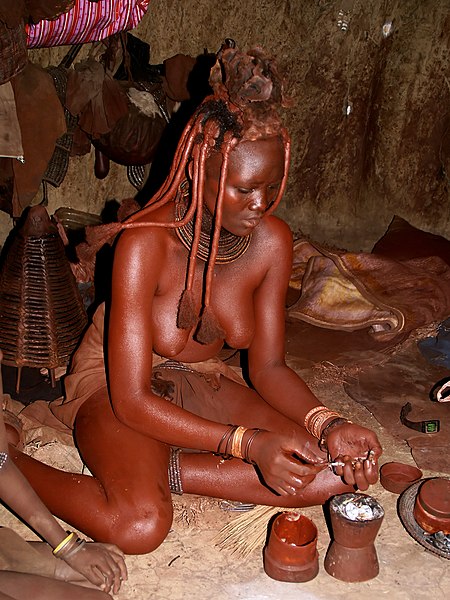

quote:^^^^^^This Kingdom in what is today Ethiopia, reached the hight of its power under its first Christian ruler Ezana (330–356 AD). (Text) Inscription above found in Meroe
Originally posted by osirion:
I took the field against the Noba when the people of Noba revolted and did violence to the Mangurto; Hasa and Barya, and the Black Noba waged war on the Red Noba. I fought on the Takkaze [Atbara] at the ford of Kemalke. They fled, and I pursued the fugitives twenty-three days slaying them and capturing others and taking plunder; I burnt their towns, and seized their corn and their bronze and the dried meat and the images in their temples and destroyed the stocks of corn and cotton; and the enemy plunged into the river Seda.

![[Big Grin]](biggrin.gif)

quote:What Nubian? is he speaking of the Nuba? what of the Kushities were they not supposed to the "Nubians" that's why that term need to be done away with unless one is referring to moderns who called themselves that.
It is assumed that the Nubians gradually infiltrated the Kushite state, with or without the acquiescence of the Kushite rulers,
quote:Is this supposed to be an answer to my questions?
Originally posted by the lioness:
Himba women as pictured photos in previous posts above are famous for covering themselves with otjize, a mixture of butter fat and red ochre pigments and herbs.This ointment is said to protect the Himba women from the intense desert sun, but its primary function is esthetic as the women believe this makes them more attractive. Some say that the brownish color that the ointment produces represents the earth while the reddish tinge symbolizes blood. This same earthy ointment is applied to their braided hair, making Himba women some of the most exotic women of all the African tribes.
quote:OK.
Show me a photo of a tribe were people are jet black and red. [/QB]







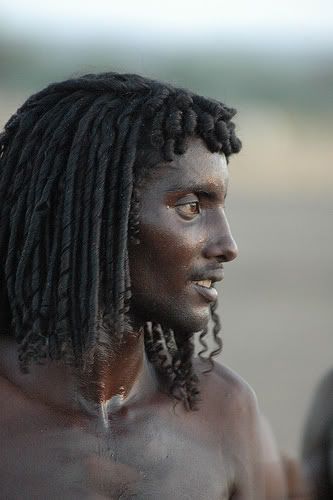
quote:
Originally posted by the lioness:
quote:I didn't realize you were this ignorant. Red and Black are the primary colors of Africans. I already cited you accounts by the Romans, Greeks and even Egyptians. There were Red and Black Noba. Why would Black noba go to war against Red painted Noba? Why would the Romans actually show prejudice against Black Noba and prefer the Red over them?
Originally posted by the lioness:
Himba women as pictured photos in previous posts above are famous for covering themselves with otjize, a mixture of butter fat and red ochre pigments and herbs.This ointment is said to protect the Himba women from the intense desert sun, but its primary function is esthetic as the women believe this makes them more attractive. Some say that the brownish color that the ointment produces represents the earth while the reddish tinge symbolizes blood. This same earthy ointment is applied to their braided hair, making Himba women some of the most exotic women of all the African tribes.
Show me a photo of a tribe were people are jet black and red.



quote:
Originally posted by osirion:
There were Red and Black Noba. Why would Black noba go to war against Red painted Noba? Why would the Romans actually show prejudice against Black Noba and prefer the Red over them?

quote:I am getting disappointed with you. I thought you were more intelligent than this. Red and Black Noba were not always at War with each other. And no, I am not aware of any distinction made by the accounts of the ancients that there was any physiological difference between the Red Noba and the Black. I can say that the Greeks and Romans definitely consider the Red Noba to be the ones that originated Nubian civilization. It is probably very similar to the Rwandan situation between the Tutsi and the Hutus. Tutsi being the Red Bantu and the Hutus being the Black as an analogy.
Originally posted by the lioness:
quote:
Originally posted by osirion:
There were Red and Black Noba. Why would Black noba go to war against Red painted Noba? Why would the Romans actually show prejudice against Black Noba and prefer the Red over them?
Why would two tribes who were at war be shown in one scene alternating like this?
Aksum an African Civilization of Late Antiquity
We know from Ezana's `monotheist' inscription (Ch. 11: 5) that the Aksumites recognised the Black (tsalim) and the Red (qayh) peoples, mentioning also the `Red Noba'; but it is not clear where in these categories they fitted themselves. Littmann (1913) thought that the implication was of the `red' people of the kingdom of Aksum in contrast to the `black' Noba (and others), a differentiation which still applies today in the eyes of the northern Ethiopians. Both Drewes (1962: 98) and Schneider (1961: 61-2), whose particular study has been the pre-Aksumite inscriptions, have come to the conclusion that even in the time of the kingdom of D`MT this contrast was used. The expression `the entire kingdom' was rendered in the geographical sense by the phrase `its east and its west', while the different characteristics of its population were illustrated by the words its red (people) and its black (people)'. If this is correct, and the two phrases are intentionally balanced, it might indicate a predominance of the `red' or semiticised population in the eastern and central part of the kingdom, as would be expected given the South Arabian influences apparent from the material remains found there.
quote:The livestock are also depicted quite accurately. No need for sarcasm buddy.
Originally posted by Confirming Truth:
^^As well as the livestock, lioness, why depict the livestock in like manner, red and black? This is why Afro-centrists will keep looking like idiots.
quote:
Originally posted by SAUCE CODE:
quote:The livestock are also depicted quite accurately. No need for sarcasm buddy.
Originally posted by Confirming Truth:
^^As well as the livestock, lioness, why depict the livestock in like manner, red and black? This is why Afro-centrists will keep looking like idiots.
quote:you can say that based on what source?
Originally posted by osirion:
quote:I can say that the Greeks and Romans definitely consider the Red Noba to be the ones that originated Nubian civilization.
Originally posted by the lioness:
Aksum an African Civilization of Late Antiquity
`red' people of the kingdom of Aksum in contrast to the `black' Noba (and others), a differentiation which still applies today in the eyes of the northern Ethiopians.
Both Drewes (1962: 98) and Schneider (1961: 61-2), whose particular study has been the pre-Aksumite inscriptions, have come to the conclusion that even in the time of the kingdom of D`MT this contrast was used.
The expression `the entire kingdom' was rendered in the geographical sense by the phrase `its east and its west', while the different characteristics of its population were illustrated by the words its red (people) and its black (people)'. If this is correct, and the two phrases are intentionally balanced
it might indicate a predominance of the `red' or semiticised population in the eastern and central part of the kingdom, as would be expected given the South Arabian influences apparent from the material remains found there.




quote:Good, at least now you are analyzing fact. Give me some time, this stuff I read over 20 years ago in College.
Originally posted by the lioness:
quote:you can say that based on what source?
Originally posted by osirion:
quote:I can say that the Greeks and Romans definitely consider the Red Noba to be the ones that originated Nubian civilization.
Originally posted by the lioness:
Aksum an African Civilization of Late Antiquity
`red' people of the kingdom of Aksum in contrast to the `black' Noba (and others), a differentiation which still applies today in the eyes of the northern Ethiopians.
Both Drewes (1962: 98) and Schneider (1961: 61-2), whose particular study has been the pre-Aksumite inscriptions, have come to the conclusion that even in the time of the kingdom of D`MT this contrast was used.
The expression `the entire kingdom' was rendered in the geographical sense by the phrase `its east and its west', while the different characteristics of its population were illustrated by the words its red (people) and its black (people)'. If this is correct, and the two phrases are intentionally balanced
it might indicate a predominance of the `red' or semiticised population in the eastern and central part of the kingdom, as would be expected given the South Arabian influences apparent from the material remains found there.
quote:Of course its stylized. Egyptian art is heavily stylized. In this case there were a Noba people that had the color of Egyptians and there were a very Black colored people as well (same type of people to the Egyptian) This was a generalized perception of the physical distinction of these people to the South. Go to Africa and you will see these distinctions as well between tribes that neighbor each other.
Originally posted by Confirming Truth:
For Fvck's sake! Any moron can tell that this painting is stylized! Look at the fvcking arrangement of the colors and every damn thing in it is red and black! TEN BLACK PEOPLE, TEN RED PEOPLE!

quote:
Originally posted by osirion:
quote:Of course its stylized. Egyptian art is heavily stylized. In this case there were a Noba people that had the color of Egyptians and there were a very Black colored people as well (same type of people to the Egyptian) This was a generalized perception of the physical distinction of these people to the South. Go to Africa and you will see these distinctions as well between tribes that neighbor each other.
Originally posted by Confirming Truth:
For Fvck's sake! Any moron can tell that this painting is stylized! Look at the fvcking arrangement of the colors and every damn thing in it is red and black! TEN BLACK PEOPLE, TEN RED PEOPLE!

quote:As You can see the Kushite Princess(In the Chariot under the Umbrella, this pretty much debunks and destroys the Lyin-ass whole argument)..
Originally posted by Just call me Jari:
Arrival of an Ethiopian Princess to the viceroy of Kush..(Princess is in the chariot just before the procession of handcuffed slaves)...
Color Version

quote:
Originally posted by the lioness:
.
Show me an ancient Egyptian painting of a Kushite (or "Nubian" ) woman
,
thank you,
lioness productions
quote:Yes, she has a unique way of answering questions. lol
Originally posted by awlaadberry:
quote:Is this supposed to be an answer to my questions?
Originally posted by the lioness:
Himba women as pictured photos in previous posts above are famous for covering themselves with otjize, a mixture of butter fat and red ochre pigments and herbs.This ointment is said to protect the Himba women from the intense desert sun, but its primary function is esthetic as the women believe this makes them more attractive. Some say that the brownish color that the ointment produces represents the earth while the reddish tinge symbolizes blood. This same earthy ointment is applied to their braided hair, making Himba women some of the most exotic women of all the African tribes.
quote:
Originally posted by osirion:
quote:Interesting but stupid argument. There are more than pictures in history. There are the accounts according to Roman and Greek officials who called these people the Noba. According to the Romans there were Red and Black Noba.
Originally posted by Confirming Truth:
The idiot is using the following pix to "prove" his claim. Notice the henna on the lion's mane and hair of the black Nubians. This suggests that the red Nubians are red because of Henna use, not because of skin complexion. Once again, Afrocentric Epic Fail.

The people mentioned in Greek, Roman, Aksumite, Byzantine, and Arab sources are as follows: Nubae, Nobades, Nobates, Annoubades, Noba, Nouba, and Red Noba.


